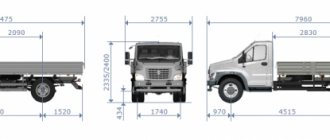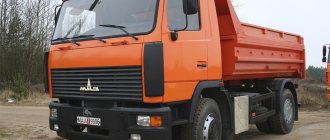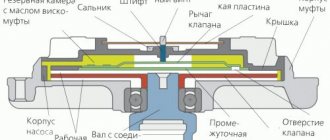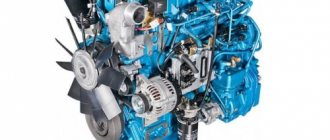ZIS-150 Soviet post-war truck.
Specifications
Engine ZIS-150
Photos of ZIS-150
ZIS-150 power supply system
photo ZIS-150 onboard
ZIS-150
- the first post-war truck of the Moscow Automobile Plant.
The Great Patriotic War prevented the ZIS-15
, designed to replace the ZIS-5, from being brought into mass production. In 1943, they began to design the ZIS-150. The first experimental ZIS-150 was built at the beginning of 1944. The International KP11 served as the basis for the Soviet truck, only the hood and radiator trim were original. The second prototype was built at the beginning of 1945. The original cabins were already installed on it. In 1947, the third prototype of the ZIS-150 was ready. The plant limited itself to three prototypes, which did not pass the full test cycle. October 30, 1947, the first batch of ZIS-150. On January 27, 1948, assembly of the conveyor line began. Until April 26, 1948, the ZIS-150 and its predecessor ZIS-50 were assembled at the plant in parallel.
photo crane on ZIS-150 chassis
ZIL-170 (model developed for the new KamAZ plant)
In the mid-60s, specialists from the Likhachev plant developed a new model of the ZIL-170 cabover truck, built prototypes and tested them. But by decision of the Soviet government, this model was transferred to the new Kama Automobile Plant in Naberezhnye Chelny, and became the basis for the first model of this enterprise - KamAZ-5320.
The ZIL-170 was equipped with a YaMZ-740 (KAMAZ-740.10) diesel engine with a power of 210 hp, a five-speed gearbox with a divider, and a locked center differential.
ZIS-150 power supply system
The power supply system is forced, with gasoline supplied by a B-6 diaphragm-type fuel pump. The main sediment filter is a slot type, with a filter element made of a set of thin brass plates (on some cars, a mesh type filter with a filter element made of fine brass mesh was installed).
On June 26, 1956, the Moscow Automobile Plant named after I.V. Stalin was renamed the Moscow Automobile Plant named after I.A. Likhachev. Accordingly, the designation of the products changed - from August of the same year, the ZIS-150 began to be called the ZIL-150. The corresponding inscription “ZIL” appeared instead of the previous “ZIS”. Production of the ZIL-150 was discontinued on October 7, 1957, and production of the modernized ZIL-164 began. A total of 771,883 ZIS-150 trucks were produced.
Possibility of boosting the ZIS-120 engine and the advantages of V-engines
The introduction of a new engine model into production requires large investments both in manufacturing and in its operation and repair. Therefore, the decision to switch to the production of a new model can be made only after the full use of the resources of the engine model currently in production. Such a model at the automobile plant named after. I. A. Likhachev had a six-cylinder lower-valve engine ZIS-120 with a single-row arrangement of cylinders. At the beginning of production, this engine, intended for installation in a ZIS-150 vehicle with a lifting capacity of 4 tons, had the main parameters given in table. 1.
Improvements were made to the design of the ZIS-120 engine, which made it possible to produce modifications with higher parameters, for example the ZIL-158V engine. Comparison of data from table. 1 shows that engine power has increased by 22.5% and torque by 13%. This was achieved mainly by increasing the compression ratio, increasing the nominal crankshaft speed and using a more advanced carburetor, which made it possible to improve the filling of the engine cylinders.
Special work carried out to determine the possibility of boosting the ZIS-120 engine showed the following:
- Increasing the compression ratio leads to a slight increase in power and torque, but at the same time the required octane number of fuel increases significantly.
- Improving cylinder filling by expanding the flow sections of the intake tract is impossible, since it is impossible to increase the size of the valves due to their close location in the combustion chamber. The distance between the valve heads and the combustion chamber walls is small and is nominally 3.85 mm for both the intake and exhaust valves. Further increases in the diameter of the valve heads further reduce the flow area around them.
- Increasing the engine displacement is only possible by correspondingly changing the cylinder diameter, since a change in the piston stroke is prevented by the small gap between the camshaft cams and the lower connecting rod heads. However, it was not practically possible to increase the cylinder diameter, since with an increase in the working volume of the cylinders it is difficult to ensure their satisfactory filling. In addition, this reduces the width of the passage for water between the cylinders, which even with the existing diameter of the cylinders is only 4 mm.
For short-term experiments, an engine was nevertheless built with the cylinder diameter increased to 108 mm due to the installation of “wet” liners. The engine displacement increased by 13% and became 6.27 liters. With a compression ratio of 6 and a correspondingly expanded intake tract, this engine developed a power of 115 hp. With. (increase by 19%) and torque 35.5 kgf-m (increase by 15%).
- The use of overhead valves is equivalent to creating a new engine, which requires special equipment to produce new parts (including complex ones such as the cylinder head and block). However, this path has also been tested.
During testing, overhead valve engines with a compression ratio of 6.5 developed a maximum power of up to 130 hp. With. at n = 2800 rpm and maximum torque up to 39 kgf-m. Tests have also shown that these engines have increased wear of the main parts: cylinders, crankshaft journals, pistons, valve guides, etc. These engines, like lower valve engines, do not have reserves for further boost. Thus, the studies have shown that the six-cylinder in-line engine, both lower-valve and overhead-valve, does not meet the requirements for engines of modern trucks, and it is obvious that it is irrational to use such a cylinder arrangement for the family of new ZIL engines. Therefore, for the new engines, a V-shaped arrangement of cylinders with a camber angle between the rows of 90° was adopted. Compared to an in-line lower-valve engine, a V-shaped overhead valve engine has a number of advantages:
- Smaller length and height of the engine, which simplifies its installation on a modern truck.
- Smaller overall dimensions of the engine, and therefore less weight.
- Greater torsional rigidity of the crankshaft (due to a reduction in its length), virtually eliminating the need to install a torsional vibration damper.
- The shorter length of the intake channels and the identity of their shape ensure a high filling coefficient and greater uniformity of distribution of the working mixture among the cylinders.
- Possibility of increasing valve diameters. This is due to the fact that in a V-shaped engine the distance between its cylinders is greater than in a single-row engine (with the same displacement of one cylinder), and therefore it is possible to increase the length of the combustion chamber and, accordingly, the size of the valves.
For example, we can compare the V-shaped ZIL-375 engine with the single-row ZIL-164A engine, the working volumes of one cylinder differ by only 6%, and each of these engines, with the accepted distance between the cylinder axes, is made with the largest possible cylinder diameter ( Fig. 1).
In a single-row engine, the distance between the axes of the cylinders is determined by the dimensions of the valves (which must be sufficient to satisfactorily fill the cylinders at the crankshaft speed corresponding to maximum power), the distances between the valves, between the valves and the walls of the combustion chamber, and the width of the bridge between adjacent combustion chambers. In a V-shaped engine, in addition to the above factors, one more is added: the need to place two connecting rods on one crankpin. In this regard, the distance between the axes of the cylinders in a V-shaped engine is determined by the sum of the longitudinal dimensions of the journals and cheeks of one crankshaft crank and in the ZIL-375 engine it is equal to 135 mm, which is 17.5 mm greater than this distance in the single-row ZIL-164A engine .
Accordingly, in the ZIL-375 engine the cylinder diameter is 6.4 mm larger and the combustion chamber is 12.5 mm longer than in the ZIL-164A engine, which makes it possible to increase the valve sizes, improve cylinder filling and increase engine power.
- An increase in the diameter of the cylinders and a corresponding decrease in the piston stroke make it possible to reduce its average speed, and therefore reduce friction losses, as well as wear of parts of the cylinder-piston group. All this increases the durability of the engine.
- The possibility of increasing the area of the displacers in the combustion chamber promotes turbulence of the charge, as a result of which combustion efficiency and engine power are increased and fuel with a lower octane number can be used.
- A decrease in the crank radius leads to an increase in the overlap of the main and connecting rod journals of the crankshaft (22.75 mm for the ZIL-375 engine and 6.85 mm for the ZIL-164A engine), resulting in increased rigidity of the crankshaft of a V-shaped engine.
- The relatively short length and high rigidity of the crankshaft in a V-shape make it possible to boost the engine's compression ratio.
- The possibility of increasing the flow sections of the intake and exhaust tracts allows for further boosting of the engine also in terms of rotation speed.
On this topic:
Removing the power unit
Checking compression in engine cylinders
Crankshaft Seals and Thin Wall Liners
Foreign production of ZIS-150
According to Soviet technical documentation, the release of the ZIS-150: - in China in 1953 at Auto Plant No. 1 under the name Jiefang CA10 (“Liberation”); - in Romania in 1954 at the Steagul Rosu (“Red Banner”) enterprise under the name SR101. Both cars were externally different from the prototype - the Chinese version was distinguished by stampings on the hood flaps and above the radiator grille, and the Romanian one received a wood-metal cabin (already in 1955 it was replaced by an all-metal one), original doors, wheel rims and original stampings on the hood flaps and above. radiator grille. The release of the ZIS-150 served as the beginning of a long journey in the automotive industry for both companies. The Chinese enterprise is now called China First Automotive Group Corporation (abbreviated FAW) and its products are known on all continents, but the Romanian one is going through hard times - the production of trucks in 2014 amounted to only 12 units.
ZIL-131 (1966-1994)
This three-axle off-road truck, with a 6x6 wheel arrangement, was produced mainly for the needs of the Soviet Army, as well as for servicing oil and gas, railway, etc. industries in hard-to-reach regions. Drilling rigs, fuel tankers and other special equipment were massively mounted on the ZIL-131 chassis.
At the Ural Automotive Plant, production of the ZIL-131N continued until 2002, including with a diesel engine. And initially the engine on the ZIL-131 was the same as on the ZIL-130: a carburetor V-shaped eight-cylinder.
Photos of ZIS-150 modification
photo ZIS-150 dump truck
photo ZIS-150 semi-trailer
photo ZIS-150 KUNG
photo ZIS-150 tank
photo ZIS-150 gas generator
ZIL-49061 “Blue Bird” (1980-1991)
The most famous special equipment produced by the Likhachev plant is the ZIL-49061 “Blue Bird,” an all-terrain vehicle for searching and evacuating landed cosmonauts. It was produced from 1980 to November 1991. And the first prototype of the car was built back in 1971.
The Blue Bird complex included special-purpose vehicles that provided solutions to the problems of searching for and evacuating re-entry vehicles of spacecraft and their crews: the ZIL-4906 (PEM-1) truck, with a closed passenger cabin and an air conditioning system, as well as thermal and noise insulation, ZIL-49061 (PEM-1M), as well as auger-driven snow and swamp-going vehicle ZIL-29061.
A total of 26 such vehicles were produced, 14 of them in the cargo-passenger version and 12 in the cargo version.









